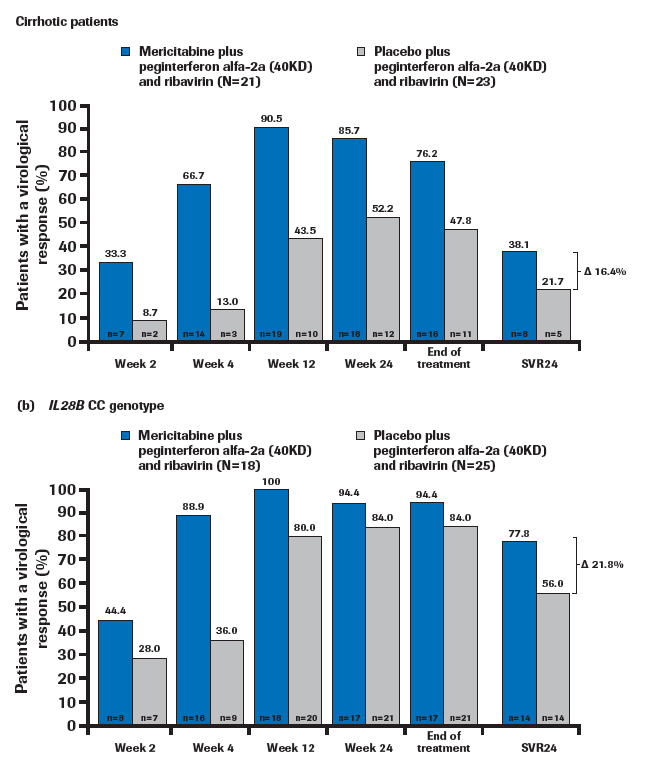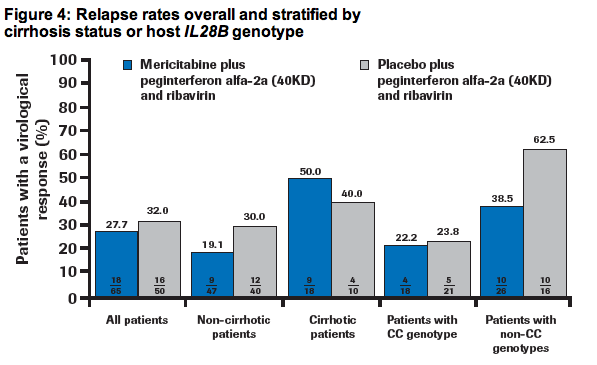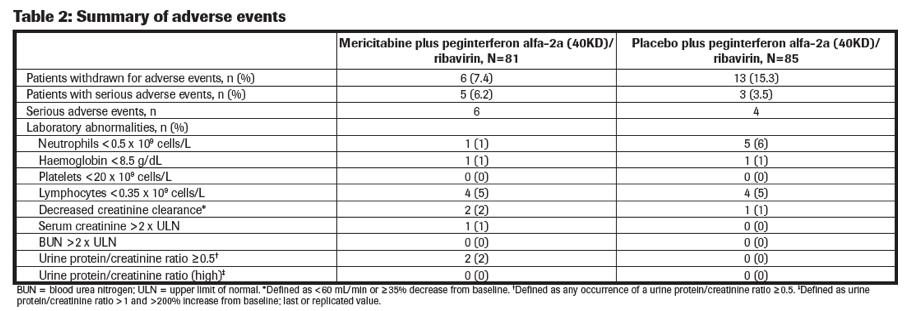 |
 |
 |
| |
SVR24 AMONG G1/4 TREATMENT-NAIVE PATIENTS RECEIVING MERICITABINE IN COMBINATION WITH PEG-IFNα-2A/RBV:
FINAL ANALYSIS FROM THE JUMP-C STUDY
|
| |
| |
Reported by Jules Levin
International Liver Congress™ 2012 [47th Annual Meeting of the European Association for the Study of the Liver (EASL)], April 18-22, Barcelona, Spain.
from Jules: week 24 responses on treatment are good with 91% undetectable but relapsers is the problem, end-of-treatment is 79% and SVR24 is 57%. The new boosted danoprevir/r data reported at this meeting is very good though with 90-96% SVR rates using the high-dose 200/100 regimen combined with peg/rbv. It appears that bossting with ritonavir gets rid of the ALT issue with unboosted ritonavir. Again, a message I've been saying is as we move forward we would like to use the best individual oral HCV drugs in combinations and boosted danoprevir/r is one of them.
EASL: RAPID AND SUSTAINED ACHIEVEMENT OF UNDETECTABLE HCV RNA DURING TREATMENT WITH RITONAVIR-BOOSTED DANOPREVIR/PEG-IFNα-2A/RBV IN HCV GENOTYPE 1 OR 4 PATIENTS: DAUPHINE WEEK 36 INTERIM ANALYSIS - (04/22/12)
EASL: RITONAVIR SUBSTANTIALLY REDUCES REACTIVE METABOLITE FORMATION OF THE HCV PROTEASE INHIBITOR DANOPREVIR BOTH IN VITRO AND IN VIVO - (04/21/12)
P.J. Pockros1, D. Jensen2, N. Tsai3, R. Taylor4, A. Ramji5, C. Cooper6, R. Dickson7, A. Tice8, R. Kulkarni9, I. Nájera10, J. Vierling11, J. Thommes9
1Scripps Clinic and Scripps Translational Science Institute, La Jolla, CA, United States, 2Center for Liver Diseases, University of Chicago Hospitals, Chicago, IL, United States, 3University of Hawaii, Honolulu, HI, United States, 4The University of Kansas Hospital Medical Center, Kansas City, KS, United States, 5Division of Gastroenterology, University of British Columbia, Vancouver, BC, Canada, 6The Ottawa Hospital, Ottawa, ON, Canada, 7Dartmouth-Hitchcock Medical Center, Lebanon, NH, United States, 8Infections Limited Hawaii, Honolulu, HI, United States, 9Genentech, South San Francisco, CA, United States, 10Roche, Nutley, NJ, United States, 11Baylor College of Medicine, Houston, TX, United States.
Conclusions
· In treatment-naive genotype 1 or 4 patients, a response-guided regimen that included 24 weeks of therapy with the combination of
mericitabine plus peginterferon alfa-2a (40KD)/ribavirin produced SVR24 rates that were 20% higher than those achieved with placebo plus
peginterferon alfa-2a (40KD)/ribavirin (56.8% vs. 36.5%, respectively).
· The mericitabine-based combination regimen produced consistently higher SVR rates in patients with and without cirrhosis and in patients
with CC and non-CC IL28B genotypes.
· Although the numbers of patients were small, logistic regression analysis showed no obvious difference in rates of SVR24 between HCV
genotype 1a vs. 1b patients.
· Combination therapy with mericitabine was safe, well tolerated and demonstrated a high barrier to resistance.
· The unique combination of potent antiviral activity, a high barrier to resistance, excellent safety profile and low potential for pharmacokinetic
drug-drug interactions make mericitabine an attractive potential component of antiviral regimens for chronic hepatitis C.
Introduction
· There is a need for direct-acting antiviral agents (DAAs) with pharmacological properties that are distinct from protease inhibitors to further optimise treatment for chronic hepatitis C.
· In particular, there is a need for effective DAAs that are better tolerated, and that have a higher barrier to resistance and a broader spectrum of activity than commercially available protease inhibitors.
· Mericitabine is a prodrug of a cytosine nucleoside analogue that is a potent, selective and non-cytotoxic HCV polymerase inhibitor.
Importantly, the drug is active against all HCV genotypes and has a high barrier to resistance.[1-4]
· In previous clinical trials in patients with chronic hepatitis C, mericitabine has been studied alone as monotherapy, in combination with peginterferon alfa-2a (40KD) plus ribavirin, and in combination with the HCV protease inhibitor danoprevir in a dual all-oral interferon-free regimen. The patient population that has received the drug in phase I and II clinical trials encompasses individuals infected with HCV genotypes 1, 2, 3 and 4, and both treatment-naive and treatment-experienced patients.[5-9]
Objective
· The objective of JUMP-C was to evaluate the efficacy and safety of 24 weeks of response-guided therapy with mericitabine plus
peginterferon alfa-2a (40KD)/ribavirin in treatment-naive patients with HCV genotype 1 or 4 infection.
Methods

· JUMP-C is a randomised, double-blind, placebocontrolled
phase IIb study in treatment-naive patients infected with HCV genotypes 1 or 4.
· Patients at 25 study centres in the United States and Canada were randomised (1:1) to receive either response-guided therapy with mericitabine 1000 mg bid plus peginterferon alfa-2a (40KD)/ribavirin for 24 or 48 weeks or placebo plus peginterferon alfa-2a (40KD)/
ribavirin for 48 weeks (Figure 1).
· Patients randomised to mericitabine with undetectable HCV RNA (<15 IU/mL) from week 4-22 (extended rapid virological response [eRVR]) stopped all treatment at week 24.
· Virological response was defined as HCV RNA <15 IU/mL (limit of detection, Roche COBAS® AmpliPrep/COBAS® TaqMan® HCV Test).
· The primary outcome of the trial was SVR24 defined as undetectable HCV RNA (<15 IU/mL) after 24 weeks of untreated follow-up.
· Baseline samples from all patients were sequenced for the purposes of the resistance analysis. Samples were also collected for resistance monitoring from patients with a viral load rebound, partial response or non-response.
- Viral breakthrough = a sustained increase in HCV RNA level of ≥1 log10 from nadir before the end of treatment with mericitabine, where
sustained is defined as ≥2 consecutive measurements, or where HCV RNA becomes quantifiable (≥43 IU/mL; 2 consecutive time points
before the end of mericitabine treatment) having been previously undetectable (<15 IU/mL).
- Non-response = a decline in serum HCV RNA level of <0.5 log10 by the end of mericitabine treatment.
- Partial response = an initial decline in serum HCV RNA of ≥0.5 log10 from baseline followed by stabilisation (defined as >2 consecutive viral load measurements within 0.5 log10 from nadir) while on mericitabine treatment and/or a serum HCV RNA level ≥1000 IU/mL at the end of mericitabine dosing of at least 4 weeks' duration.
- Relapse = response at the end of treatment but subsequently had a detectable HCV RNA at the last assessment point post treatment.
Results
· A total of 166 patients were randomised to treatment (group A, n=81; group B, n=85), received at least one dose of study medication and
comprised the intention-to-treat (ITT) population.
· There were no major differences between arms A and B in the proportion of patients who were male (63% and 79%), white
(78% and 81%), infected with genotype 1a (62% and 80%), cirrhotic (26% and 27%) or between arms A and B in baseline HCV RNA
(6.6 and 6.5 log10 IU/mL) (Table 1).
· IL28B genotyping was performed in a subset of patients (114/166, 69%) and showed that 65% and 60% of patients in groups A and B had
non-CC genotypes (Table 1).

Efficacy
· Rates of eRVR were higher among patients randomised to mericitabine plus peginterferon alfa-2a (40KD)/ribavirin (60%) compared to placebo
plus peginterferon alfa-2a (40KD)/ribavirin (13%).
· Virological response rates were consistently higher, during both treatment and follow-up, in patients treated with mericitabine (Figure 2).
· Final SVR24 rates were higher in patients treated with mericitabine plus peginterferon alfa-2a (40KD)/ribavirin than in patients treated with placebo
plus peginterferon alfa-2a (40KD)/ribavirin (56.8%, CI 45.9-67.0% vs 36.5%, 27.0-47.1%; Δ = 20.3%, CI 5.5-35.2%) (Figure 2).
· Of the five patients with HCV genotype 4 randomised to the mericitabine arm, three (60%) achieved an SVR24.
· Treatment with mericitabine was also associated with consistently higher on-treatment virological response rates and SVR24 rates when patients were grouped according to cirrhosis status (Figure 3a) and host IL28B genotype (CC or non-CC) (Figure 3b).
· Logistic regression analyses were explored among all genotype 1a and 1b patients receiving mericitabine (n=74) and among the
subset of patients with host IL28B genotype information (n=47). Independent variables were genotype (1a vs. 1b), age (>50 vs. ≤50),
sex (male vs. female), race (white vs. non-white), fibrosis (F3/4 vs. F≤2), baseline HCV RNA (≥800,000 IU/mL vs. <800,000 IU/mL) and
among the subset of patients with IL28B genotype information (CC vs. non-CC).
- HCV genotype 1a vs. 1b was not a significant factor in either the overall model (p=0.9532) or in the sub-set of patients with host IL28B
genotype information (p=0.9002).



· Relapse rates were generally lower in patients who received mericitabine compared with those who received placebo (Figure 4). The greatest
difference in relapse rates was observed in patients with a non-CC IL28B genotype, among whom the relapse rates were 38.5% for mericitabine-treated
patients and 62.5% for placebo-treated patients (Figure 4).

Resistance
· A total of 31 patients met the criteria for resistance monitoring: one patient (genotype 1b) had a partial response during mericitabine therapy; nine patients
(five genotype 1a, four genotype 1b) experienced breakthrough during treatment with peginterferon alfa-2a (40KD)/ribavirin; 16 patients (nine genotype 1a,
six genotype 1b, one genotype 4) relapsed after completing 48 weeks of therapy; and five patients (four genotype 1a, one genotype 1b) discontinued treatment between weeks 4 and 12.
· The S282T mutation was not detected in samples obtained from any of the 30 patients in whom the NS5B region was successfully sequenced. Three non-polymorphic amino acid changes (D61D/G, A112A/T and D559D/N) detected in two patients showed no effect on mericitabine susceptibility (A112T or D559N) or did not replicate in vitro (D61G).
· In the one patient with a partial response during treatment with mericitabine, a mixture of wild-type and mutant L159F, I262V and L320F were detected in on-treatment and follow-up samples. Phenotypic analysis of this patient's samples showed susceptibility to mericitabine (maximum EC50 fold-shift of 1.9 compared to baseline).
Safety
· The safety profile of mericitabine did not differ greatly from that of placebo and no safety concerns were identified (Table 2).
· Fewer patients in the mericitabine treatment group (six [7.4%]) than in the placebo treatment group [13 (15.3%)] discontinued treatment for
safety reasons (Table 2).
· In total, eight patients (4.8%) experienced serious adverse events: five patients in the mericitabine group (6.2%) and three patients in the
placebo group (3.5%) (Table 2).

References
1. Stuyver LJ, McBrayer TR, Tharnish PM, et al. Inhibition of hepatitis C replicon RNA synthesis by beta-D-2'-deoxy-2'-
fluoro-2'-C-methylcytidine: a specific inhibitor of hepatitis C virus replication. Antivir Chem Chemother 2006; 17 (2):
79-87
2. Ma H, Jiang WR, Robledo N, et al. Characterization of the metabolic activation of hepatitis C virus nucleoside inhibitor
beta-D-2'-Deoxy-2'-fluoro-2'-C-methylcytidine (PSI-6130) and identification of a novel active 5'-triphosphate species. J
Biol Chem 2007; 282 (41): 29812-20
3. Leveque V, Fung A, Le Pogam S, et al. Nucleoside analog R7128, a prodrug of PSI-6130, shows inhibition potency
across HCV genotypes 1-6 in vitro. 16th International Symposium on Hepatitis C Virus and Related Viruses, Nice,
France; 2009. Poster 215
4. Ali S, Leveque V, Le Pogam S, et al. Selected replicon variants with low-level in vitro resistance to the hepatitis C virus
NS5B polymerase inhibitor PSI-6130 lack cross-resistance with R1479. Antimicrob Agents Chemother 2008; 52 (12):
4356-69
5. Reddy R, Rodriguez-Torres M, Gane E, et al. Antiviral activity, pharmacokinetics, safety, and tolerability of R7128, a novel
nucleoside HCV RNA polymerase inhibitor, following multiple, ascending, oral doses in patients with HCV genotype 1
infection who have failed prior interferon therapy. Hepatology 2007; 46 (Suppl. 4): A862
6. Gane E, Rodriguez-Torres M, Nelson D, et al. Antiviral activity of the HCV nucleoside polymerase inhibitor R7128 in HCV
genotype 2 and 3 prior non-responders: interim results of R7128 1500mg BID with PEG-IFN and ribavirin for 28 days.
Hepatology 2008; 48 (Suppl. 4): A1024
7. Rodriguez-Torres M, Lalezari J, Gane EJ, et al. Potent antiviral response to the HCV nucleoside polymerase inhibitor
R7128 for 28 days with PEG-IFN and ribavirin: subanalysis by race/ethnicity, weight and HCV genotype. Hepatology
2008; 48 (Suppl. 4): A1160
8. Gane EJ, Roberts SK, Stedman CA, et al. Oral combination therapy with a nucleoside polymerase inhibitor (RG7128)
and danoprevir for chronic hepatitis C genotype 1 infection (INFORM-1): a randomised, double-blind, placebocontrolled,
dose-escalation trial. Lancet 2010; 376 (9751): 1467-75
9. Jensen D, Wedemeyer H, Herring R, et al. High rates of early viral response, promising safety profile and lack of
resistance-related breakthrough in HCV GT 1/4 patients treated with RG7128 plus PegIFN alfa-2a (40KD)/RBV: planned
week 12 interim analysis from the PROPEL study. Hepatology 2010; 52 (Suppl. 4): A360
|
| |
|
 |
 |
|
|